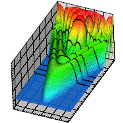Department of Physics and Astronomy: Publications and Other Research

Anthony F. Starace Publications
Document Type
Article
Date of this Version
1-14-2001
Abstract
Although it was pointed out about 10 years ago that an atomic decay rate might decrease as the intensity of a high-frequency laser field increases, there still does not exist any complete understanding of either the physical origin of this interesting nonlinear phenomenon or its dependence on the atomic and field parameters. Essentially, the problem consists in that the phenomenon requires a major modification of the standard picture of photoeffect in a strong laser field. In Reference #1 the origin of this stabilization is related to a particular distortion of an atomic potential by an intense monochromatic high-frequency field. This phenomenon is called adiabatic or quasistationary stabilization (QS). For the case of Rydberg levels, another (interference) mechanism of QS was suggested. Both theories predict an unlimited decrease of the decay rate (or of the width Γ of an atomic level, i.e., of the imaginary part of the complex quasienergy, ε = Re ε – iΓ/2 ) as the laser field amplitude increases. In recent years the idea of “dynamic stabilization” (DS) has become popular. It originates from the pulse form of a laser field rather than from any intrinsic property of the atom in a strong monochromatic field. Within this model the numerous simulations point also to the possibility of a breakdown of stabilization for the case of superintense short laser pulses. However, a recent paper, using the quasistationary quasienergy states (QQES) as an adiabatic basis for the laser pulse has shown that DS has the same (quasistationary) origin as QS. Finally, a number of authors deny the existence of stabilization, in particular, of QS for ionization from a short-range potential and of DS in pulsed fields. Obviously, these controversies and ambiguities are caused by the complexity of the numerical solution of the Cauchy problem for the time-dependent Schrödinger equation in a strong field and by the absence of analyses for exactly solvable analytical models. We analyze the exactly solvable problem of an electron in a three-dimensional, short-range potential and consider the two questions: does a QS-like behavior of the decay rate exist for this model, and, if so, is there an upper intensity limit of the QS regime?


Comments
Published in Super-Intense Laser-Atom Physics, edited by Bernard Piraux and Kazimierz Rzążewski. NATO Science Series: Series II: Mathematics, Physics and Chemistry – Vol. 12. Dordrecht / Boston / London: Kluwer Academic Publishers, 2001. Proceedings to the NATO Advanced Research Workshop on Super-Intense Laser-Atom Physics, Han-sur-Lesse, Belgium, September 24–30, 2000. Copyright © 2001 Kluwer Academic Publishers. Used by permission.